
10 Best HR Systems for Small Businesses in 2025: Comprehensive Guide
Running a small business is a whirlwind of activity. You’re juggling sales, marketing, operations, and everything in between. While you’re wearing all those hats, managing your employees effectively can easily fall by the wayside. But neglecting HR, even unintentionally, can be a costly mistake. From compliance issues and employee dissatisfaction to poor performance and high turnover, the consequences can be significant.
Fortunately, you don’t have to be an HR expert to handle your workforce well. The right HR system can automate tasks, streamline processes, and provide valuable insights, allowing you to focus on growing your business. This guide will walk you through some of the top HR SaaS software solutions available today, highlighting their strengths, weaknesses, and suitability for different types of small businesses. We’ll explore their core functionalities, pricing models, and what sets them apart in a crowded marketplace.
We’ll examine the following HR systems in detail:
- BambooHR
- Rippling
- Zenefits
- Paychex Flex
- Gusto
- Workday HCM
- Zoho People
- Namely
- ADP Workforce Now
- Sage HR
Let’s dive in.
1. BambooHR: The User-Friendly Foundation
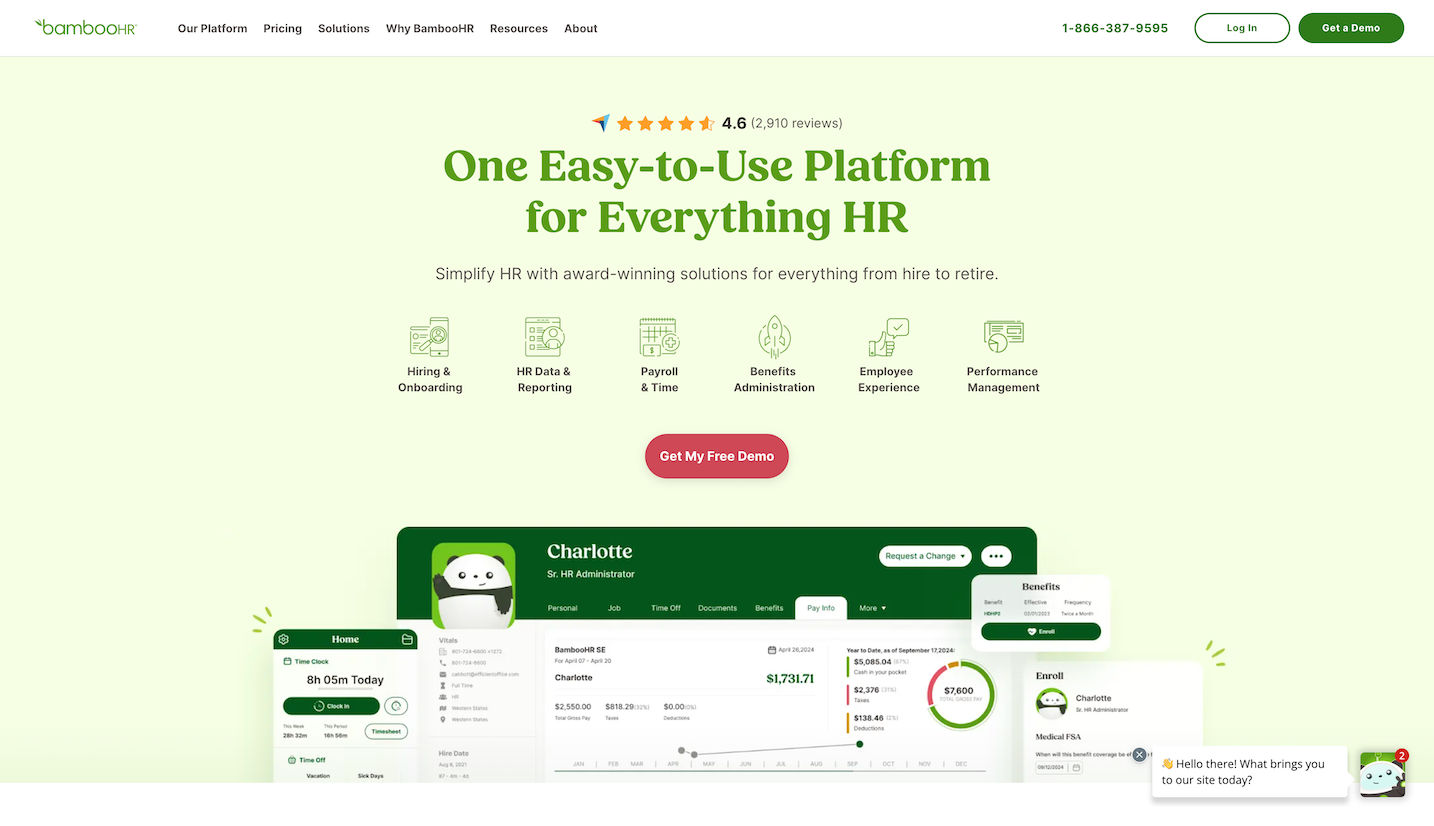
Imagine you’re building a house. BambooHR is like the strong, well-designed foundation. It provides a solid platform for managing your employees and scaling your business. It’s known for its user-friendly interface and comprehensive feature set, making it a popular choice for small to medium-sized businesses.
Core Functionalities:
- HR Database: Centralized employee records, including contact information, job history, performance reviews, and benefits information. This eliminates the need for scattered spreadsheets and manual tracking.
- Applicant Tracking System (ATS): A streamlined hiring process, from posting job openings to tracking applicants and managing interviews. It helps you find the right talent faster and more efficiently.
- Onboarding: Automated onboarding workflows that guide new hires through the necessary paperwork and training. This ensures a smooth transition and sets them up for success.
- Performance Management: Tools for setting goals, tracking progress, and conducting performance reviews. This promotes employee development and helps them align with company objectives.
- Time Tracking: Employee time tracking and attendance management, integrated with payroll. This simplifies payroll processing and ensures accurate record-keeping.
- Reporting & Analytics: Customizable reports and dashboards that provide insights into key HR metrics. This helps you identify trends, make informed decisions, and optimize your HR strategies.
- Employee Self-Service: Empower employees to manage their own information, request time off, and access company resources. This reduces the burden on HR and increases employee engagement.
- Mobile App: Employees can access important information and perform tasks from their mobile devices, enhancing flexibility and convenience.
What Sets BambooHR Apart:
BambooHR excels in its intuitive design and ease of use. It’s designed to be user-friendly for both HR professionals and employees. The focus on employee experience is evident in its clean interface and helpful self-service features. Its reporting capabilities are robust, providing valuable insights without being overly complex. Furthermore, BambooHR has a well-regarded customer support team, making it easy to get help when you need it.
The Narrative:
Sarah, the HR manager at a growing tech startup, was drowning in paperwork. She was using spreadsheets to track employee data, manually processing time-off requests, and struggling to keep up with the growing number of hires. She knew they needed a better solution. After researching various options, she chose BambooHR.
The implementation was surprisingly smooth. Within a few weeks, all employee data was migrated to the BambooHR platform. Sarah was thrilled with the automated onboarding process, which significantly reduced the time and effort required to get new hires up to speed. Employees loved the self-service portal, where they could easily request time off, update their contact information, and access company policies. The performance management module helped managers provide more structured and meaningful feedback, leading to improved employee performance. Sarah finally had the time to focus on strategic HR initiatives, such as employee development and talent management.
Pricing:
BambooHR doesn’t publicly disclose pricing. You need to contact them for a personalized quote based on the number of employees and the features you need. While this lack of transparency can be frustrating, it allows them to tailor the pricing to your specific needs. Expect it to be in the mid-to-high range compared to other options.
Pros:
- User-friendly interface
- Comprehensive feature set
- Excellent onboarding tools
- Robust reporting & analytics
- Strong customer support
- Well-regarded employee self-service portal
Cons:
- No publicly available pricing
- Can be expensive for very small businesses
Verdict:
BambooHR is an excellent choice for small to medium-sized businesses that are looking for a user-friendly and comprehensive HR system. It’s particularly well-suited for companies that value employee experience and want to streamline their HR processes. However, its pricing may be a barrier for very small businesses with tight budgets.
2. Rippling: The All-in-One Powerhouse
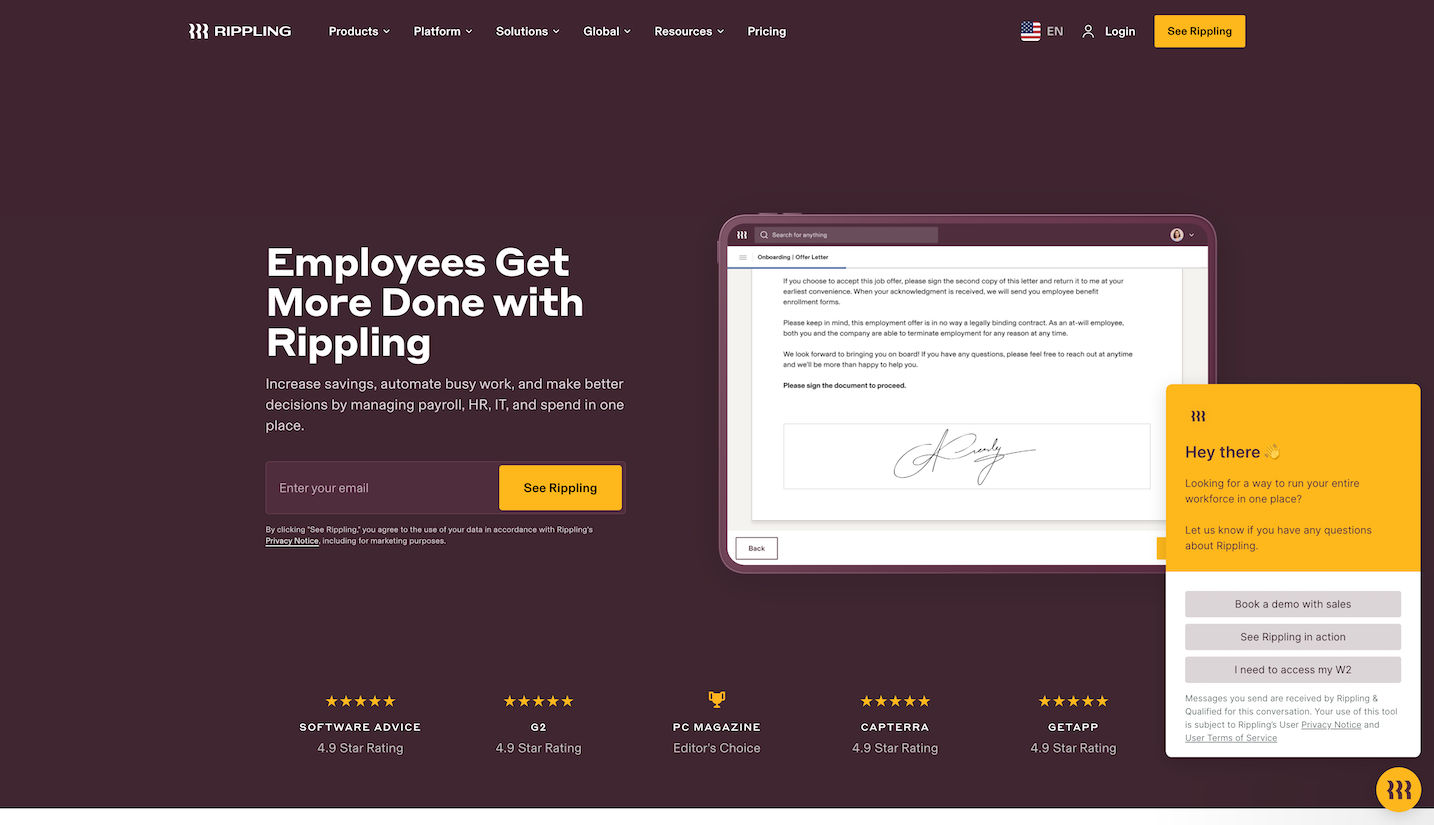
Imagine Rippling as the complete smart home system. It not only manages your HR functions but also integrates seamlessly with your IT systems, creating a truly unified platform. It’s designed to automate a wide range of tasks, from onboarding and payroll to app management and device security.
Core Functionalities:
- HR Management: Core HR features like employee records, org charts, and time-off management.
- Payroll: Automated payroll processing, tax filing, and compliance management.
- Benefits Administration: Online enrollment, benefits tracking, and reporting.
- IT Management: Onboarding and offboarding of employees across various applications and devices. Automatic provisioning and deprovisioning of software licenses.
- App Management: One-click onboarding and offboarding of employees across various applications, such as Slack, Zoom, and Google Workspace.
- Device Management: Securely manage employee devices, including laptops, phones, and tablets.
- Workflows: Automate complex HR and IT processes with custom workflows.
What Sets Rippling Apart:
Rippling’s key differentiator is its ability to manage both HR and IT functions within a single platform. This integration can save significant time and effort, especially for companies with a large number of applications and devices. The app management and device management features are particularly valuable for businesses that rely heavily on technology. Its robust automation capabilities are a major selling point, streamlining complex processes and reducing manual work.
The Narrative:
A fast-growing SaaS company, “Innovate Solutions,” was struggling to manage its expanding workforce and increasingly complex IT infrastructure. Onboarding a new employee involved creating accounts in multiple applications, setting up their laptop, and ensuring they had the necessary access. Offboarding was even more challenging, requiring manual revocation of access to each application and device. The HR and IT teams were constantly battling bottlenecks and struggling to keep up.
They implemented Rippling. Suddenly, onboarding became a breeze. With a single click, new hires were automatically provisioned with access to all the necessary applications and devices. Offboarding was equally simple, ensuring that departing employees’ access was revoked instantly and securely. The HR and IT teams were finally able to work together seamlessly, streamlining processes and improving efficiency. The time saved was redirected to improving employee experience and driving innovation.
Pricing:
Rippling’s pricing is modular and depends on the specific features you need. You pay per user per month, and the price varies depending on the modules you select. This allows you to customize the platform to your specific needs and budget. Contact Rippling directly for a quote. Expect the cost to be competitive but potentially higher than basic HR solutions if you use a lot of the features.
Pros:
- Unified HR and IT management
- Powerful automation capabilities
- Seamless app integration
- Comprehensive device management
- Modular pricing
- Excellent onboarding and offboarding processes
Cons:
- Can be complex to set up and configure
- Pricing can be higher than other solutions, especially with many modules
- Might be overkill for very small businesses with simple IT needs
Verdict:
Rippling is a powerful and comprehensive solution for small to medium-sized businesses that want to streamline their HR and IT operations. It’s particularly well-suited for companies that rely heavily on technology and have complex IT infrastructures. While it can be more expensive than other options, the time savings and increased efficiency can justify the investment.
3. Zenefits: The Affordable Entry Point
Zenefits aims to be an accessible HR solution, especially for very small businesses. Think of it as a starter kit for HR management, offering core functionalities at a competitive price point. It provides a centralized platform for managing employee data, benefits, and payroll.
Core Functionalities:
- HR Management: Employee database, org charts, and document management.
- Benefits Administration: Health insurance enrollment, benefits tracking, and compliance management.
- Payroll: Payroll processing, tax filing, and compliance management.
- Time & Attendance: Time tracking, attendance management, and paid time off (PTO) tracking.
- Hiring: Basic applicant tracking and onboarding features.
- Compliance: Tools to assist with compliance requirements.
What Sets Zenefits Apart:
Zenefits is known for its affordable pricing and user-friendly interface. It’s designed to be easy to set up and use, even for businesses with limited HR expertise. The integrated benefits administration is a key selling point, simplifying the complex process of managing employee benefits. It’s also one of the more affordable entry points if you’re just starting out.
The Narrative:
A small bakery, “Sweet Delights,” was struggling to manage its growing team. The owner, Maria, was spending hours each week tracking employee hours, processing payroll, and managing benefits. She knew she needed an HR solution, but she was concerned about the cost.
Maria chose Zenefits because of its affordable pricing and ease of use. She was able to quickly set up the platform and migrate her employee data. The automated payroll processing saved her hours each week, and the integrated benefits administration made it easy to manage her employees’ health insurance. She finally had the time to focus on what she loved: baking delicious treats and growing her business.
Pricing:
Zenefits offers various pricing plans based on the features you need. The basic plan is relatively affordable, making it a good option for very small businesses with limited budgets. As you need more features, you can upgrade to a higher-tier plan. Check Zenefits’ website for current pricing details.
Pros:
- Affordable pricing
- User-friendly interface
- Integrated benefits administration
- Easy to set up and use
Cons:
- Customer service can be inconsistent.
- Some users have reported issues with accuracy and reliability.
- Feature set is not as comprehensive as some other solutions.
Verdict:
Zenefits is a good option for very small businesses that are looking for an affordable and easy-to-use HR solution. It’s particularly well-suited for companies that need help with benefits administration. However, businesses with more complex HR needs may want to consider a more comprehensive solution. Be sure to vet their customer support offerings before committing.
4. Paychex Flex: The Established Player
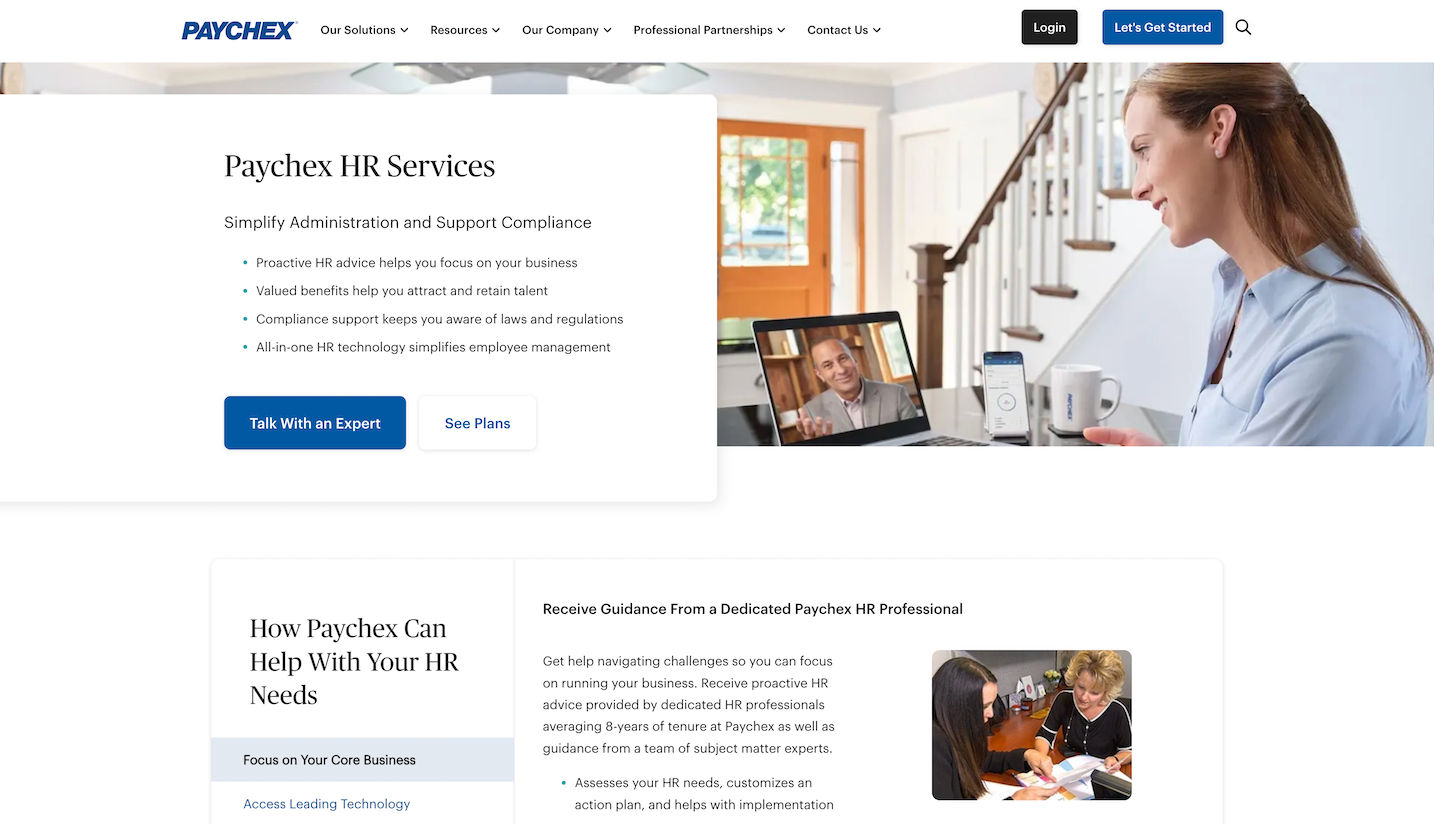
Paychex Flex is a well-established HR and payroll provider with a long history in the industry. Think of it as the reliable, experienced contractor who has seen it all. It offers a wide range of services, from payroll processing and HR management to benefits administration and insurance.
Core Functionalities:
- Payroll: Payroll processing, tax filing, and compliance management.
- HR Management: Employee database, org charts, and document management.
- Benefits Administration: Health insurance enrollment, benefits tracking, and compliance management.
- Time & Attendance: Time tracking, attendance management, and paid time off (PTO) tracking.
- Hiring: Applicant tracking and onboarding features.
- Insurance: Health insurance, workers’ compensation, and other insurance products.
- Learning Management System (LMS): Employee training and development platform.
What Sets Paychex Flex Apart:
Paychex Flex’s key differentiator is its comprehensive suite of services and its long history in the industry. It offers a wide range of options, allowing you to customize the platform to your specific needs. The insurance offerings are a major selling point for businesses that want to simplify their benefits administration. The established reputation provides peace of mind for some business owners.
The Narrative:
A growing manufacturing company, “Precision Parts,” needed a reliable HR and payroll provider that could handle its complex payroll requirements and benefits administration. The company had a large number of employees, many of whom worked different shifts and had different benefits packages.
“Precision Parts” chose Paychex Flex because of its comprehensive services and established reputation. The platform was able to handle the company’s complex payroll requirements with ease, and the benefits administration module simplified the management of employee benefits. The company also appreciated the access to Paychex’s insurance products, which helped them provide competitive benefits packages to their employees. The HR team felt confident knowing they had a trusted partner to handle their HR and payroll needs.
Pricing:
Paychex Flex’s pricing is complex and depends on the specific services you need. You need to contact them for a personalized quote. Expect the cost to be competitive but potentially higher than some other solutions, especially if you use a wide range of services.
Pros:
- Comprehensive suite of services
- Established reputation
- Insurance offerings
- Scalable platform
Cons:
- Pricing can be complex and difficult to understand
- Customer service can be inconsistent
- Interface can feel outdated compared to some newer solutions
Verdict:
Paychex Flex is a good option for small to medium-sized businesses that are looking for a comprehensive HR and payroll provider with a long history in the industry. It’s particularly well-suited for companies with complex payroll requirements and benefits administration needs. However, be prepared for a potentially complex pricing structure and inconsistent customer service.
5. Gusto: The Employee-Centric Solution
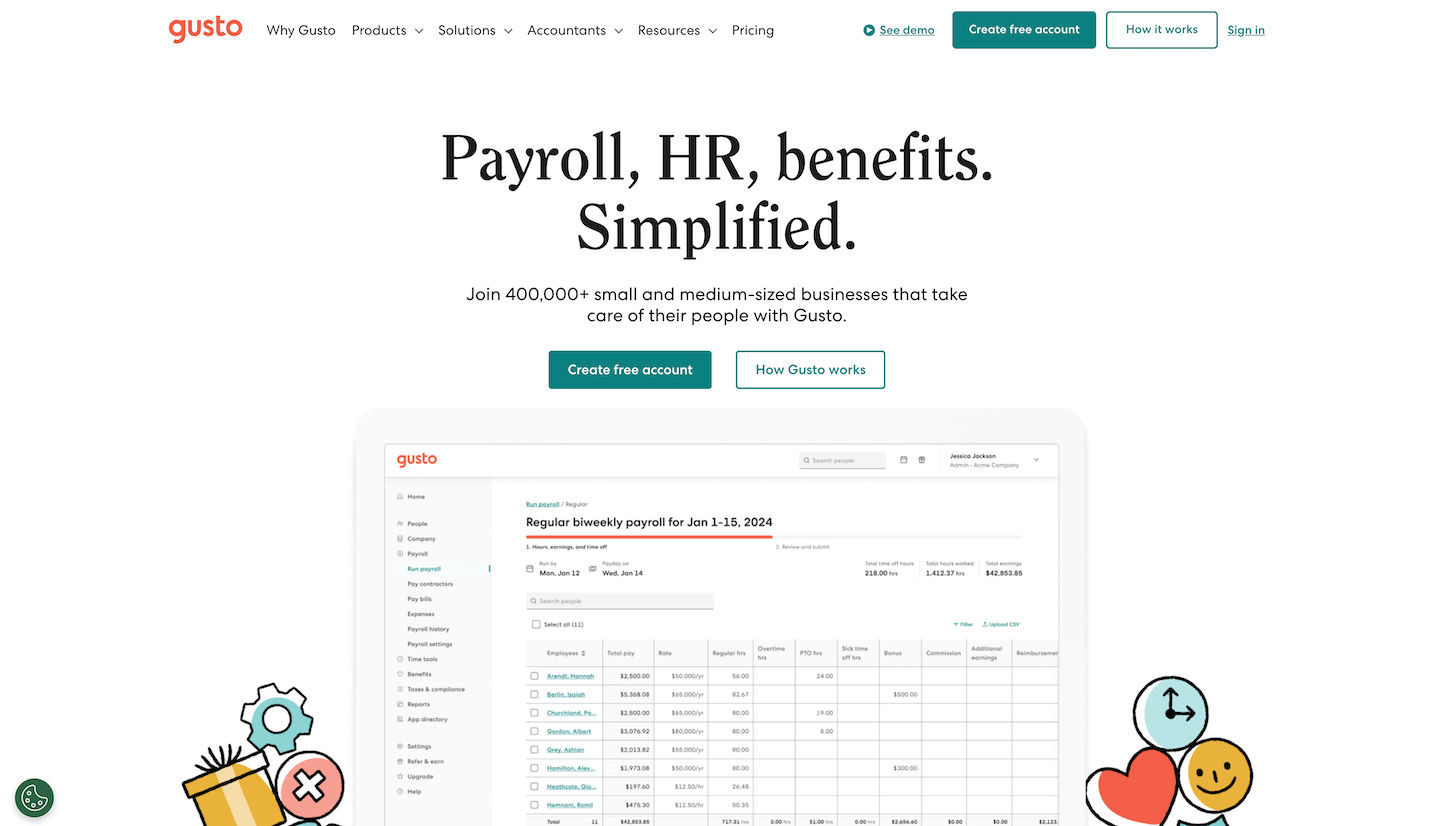
Gusto positions itself as an HR and payroll solution with a strong focus on employee experience. Imagine it as the friendly, approachable HR partner who truly cares about your employees’ well-being. It aims to make HR tasks simple and enjoyable for both employers and employees.
Core Functionalities:
- Payroll: Automated payroll processing, tax filing, and compliance management.
- Benefits Administration: Health insurance enrollment, benefits tracking, and compliance management.
- Time & Attendance: Time tracking, attendance management, and paid time off (PTO) tracking.
- Hiring: Applicant tracking and onboarding features.
- Employee Engagement: Employee surveys, feedback tools, and recognition programs.
- Compliance: Tools to help with compliance requirements, including ACA and EEOC reporting.
What Sets Gusto Apart:
Gusto stands out with its user-friendly interface and its strong focus on employee experience. It’s designed to be easy for both employers and employees to use. The employee engagement features are a major selling point, helping businesses create a positive and supportive work environment. The commitment to a positive payroll experience sets it apart as well.
The Narrative:
A growing marketing agency, “Creative Spark,” wanted to create a positive and engaging work environment for its employees. The agency recognized that happy and engaged employees were more productive and creative.
They implemented Gusto. The platform’s user-friendly interface made it easy for employees to manage their own information and access company resources. The employee engagement features, such as the employee surveys and feedback tools, helped the agency gather valuable feedback and identify areas for improvement. The agency also used Gusto’s recognition programs to reward employees for their hard work and contributions. As a result, “Creative Spark” saw a significant increase in employee morale and productivity.
Pricing:
Gusto offers various pricing plans based on the features you need. The basic plan is relatively affordable, making it a good option for small businesses with limited budgets. As you need more features, you can upgrade to a higher-tier plan. Visit Gusto’s website for current pricing details.
Pros:
- User-friendly interface
- Strong focus on employee experience
- Employee engagement features
- Affordable pricing
Cons:
- Limited customization options
- Reporting capabilities are not as robust as some other solutions
- Integration with other systems can be limited
Verdict:
Gusto is a good option for small to medium-sized businesses that are looking for an HR and payroll solution with a strong focus on employee experience. It’s particularly well-suited for companies that want to create a positive and engaging work environment. It is great for companies that want an emphasis on an employee-friendly HR.
6. Workday HCM: The Enterprise-Grade Solution for Growing Businesses
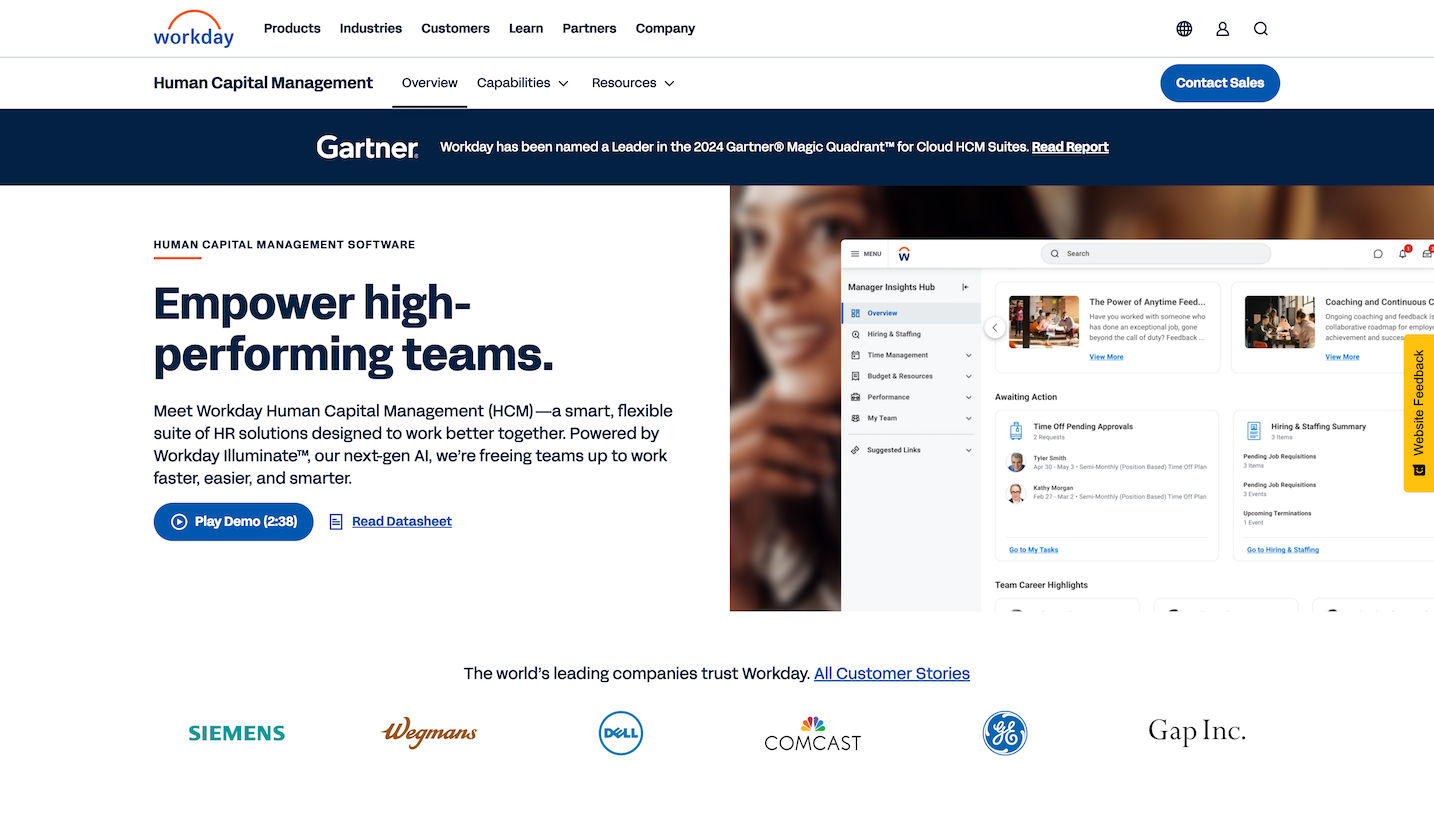
While often associated with large enterprises, Workday HCM can be a viable option for small businesses with ambitious growth plans and complex HR needs. Think of it as the high-powered engine that can scale with your business as it grows.
Core Functionalities:
- Core HR: Comprehensive employee data management, organizational structure modeling, and workforce planning.
- Talent Management: Performance management, learning and development, succession planning, and career development.
- Compensation Management: Salary planning, bonus administration, and equity management.
- Benefits Administration: Open enrollment, benefits tracking, and compliance management.
- Payroll: Payroll processing, tax filing, and compliance management.
- Time Tracking: Time and attendance tracking, absence management, and labor costing.
- Analytics and Reporting: Advanced analytics, dashboards, and custom reporting.
What Sets Workday HCM Apart:
Workday HCM distinguishes itself with its comprehensive feature set, its ability to handle complex HR processes, and its focus on analytics and reporting. It is a highly customizable platform that can be tailored to the specific needs of your business. While expensive, it is a great solution to companies that forecast rapid growth and wish to stay in the same ecosystem during scaling.
The Narrative:
“Global Tech Solutions,” a rapidly growing technology company, recognized that its existing HR system was not capable of handling its increasingly complex HR needs. The company needed a system that could support its global workforce, manage its talent effectively, and provide insightful analytics.
“Global Tech Solutions” chose Workday HCM. The platform’s comprehensive feature set allowed the company to manage its global workforce effectively, streamline its HR processes, and gain valuable insights into its workforce data. The company was able to improve its talent management, reduce its compliance risk, and make better decisions about its workforce.
Pricing:
Workday HCM is typically priced on a subscription basis, with costs depending on the number of employees and the features selected. The high cost of Workday HCM makes it a non-starter for the vast majority of small businesses, but it can be a worthwhile investment for companies with complex HR needs and a desire to scale rapidly.
Pros:
- Comprehensive feature set
- Highly customizable
- Robust analytics and reporting
- Scalable to handle growing businesses
Cons:
- High cost
- Complex implementation
- May be overkill for small businesses with simple HR needs
Verdict:
Workday HCM is a great option for small businesses with ambitious growth plans and complex HR needs. It is a powerful and comprehensive platform that can help you manage your workforce effectively, improve your HR processes, and gain valuable insights into your workforce data.
7. Zoho People: The Budget-Friendly and Versatile Option
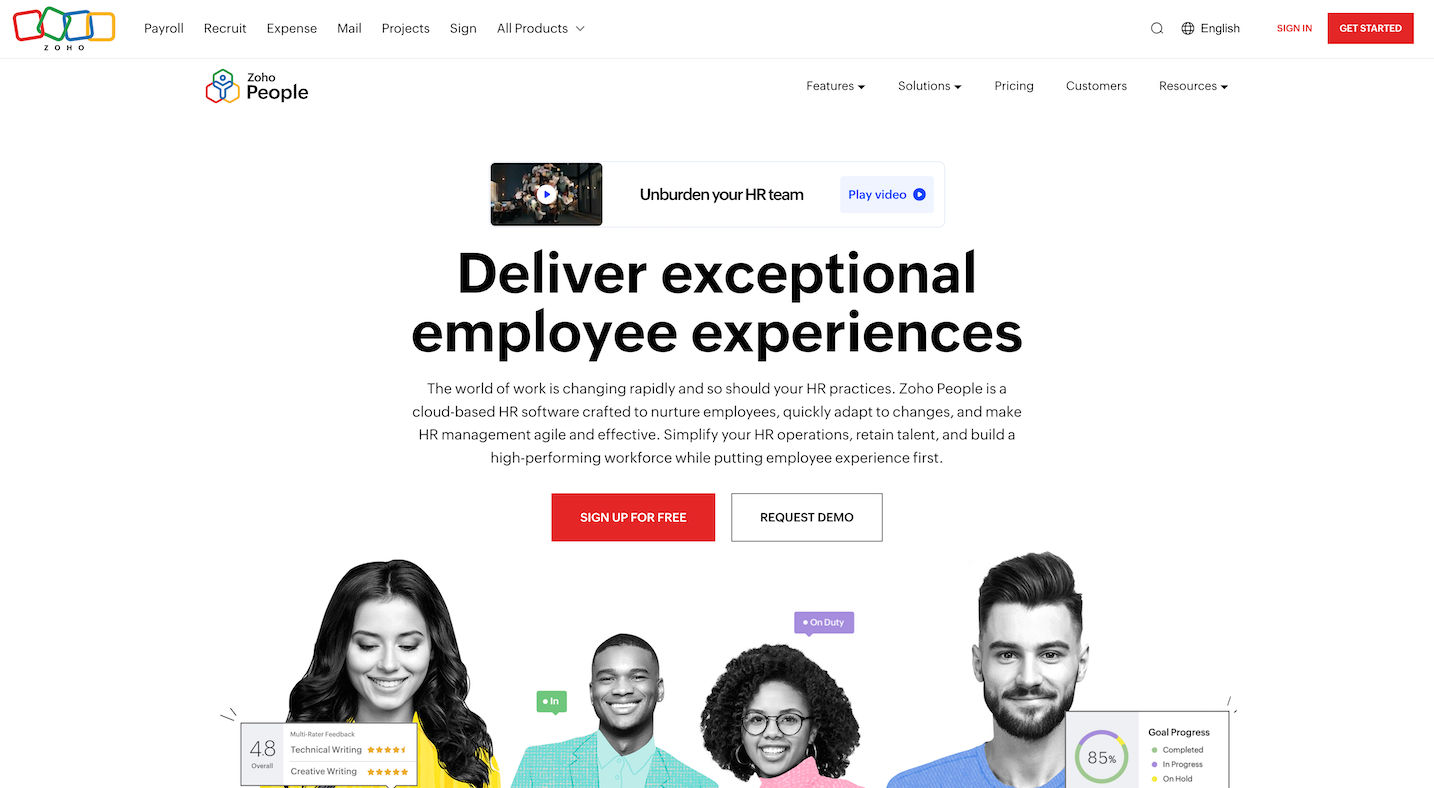
Zoho People is a cloud-based HR solution that caters to small and medium-sized businesses looking for a cost-effective and versatile HR platform. Think of it as the Swiss Army knife of HR software – offering a variety of tools in a single package.
Core Functionalities:
- Core HR: Employee database management, organizational charts, and employee self-service portals.
- Time and Attendance: Time tracking, leave management, and attendance reports.
- Performance Management: Goal setting, performance reviews, and feedback mechanisms.
- Recruitment: Job postings, applicant tracking, and onboarding processes.
- Learning Management: Training modules, course management, and employee development resources.
- Analytics: Custom reports, workforce analytics, and data visualization tools.
What Sets Zoho People Apart:
Zoho People distinguishes itself with its affordability and its integration with the broader Zoho ecosystem of business applications. It offers a robust feature set at a competitive price point, making it an attractive option for small businesses with budget constraints.
The Narrative:
“EcoFriendly Solutions,” a sustainable energy startup, needed an HR solution that could help them manage their growing workforce while staying within their budget. They were impressed by Zoho People’s comprehensive feature set and affordable pricing.
“EcoFriendly Solutions” chose Zoho People. The platform’s employee database management system allowed them to streamline their HR processes, while the time and attendance tracking system improved their workforce productivity. The performance management system helped them identify areas for improvement, and the recruitment tools made it easier to attract top talent.
Pricing:
Zoho People offers a variety of pricing plans based on the features you need. The pricing is very competitive, making it an affordable option for small businesses.
Pros:
- Affordable pricing
- Integration with the Zoho ecosystem
- Robust feature set
- Easy-to-use interface
Cons:
- Limited customization options
- Customer service can be inconsistent
- May lack advanced features found in more expensive platforms
Verdict:
Zoho People is a great option for small and medium-sized businesses looking for a cost-effective and versatile HR platform. It offers a comprehensive feature set at an affordable price, making it an attractive option for companies with budget constraints.
8. Namely: The Mid-Market HR Solution with a Social Twist
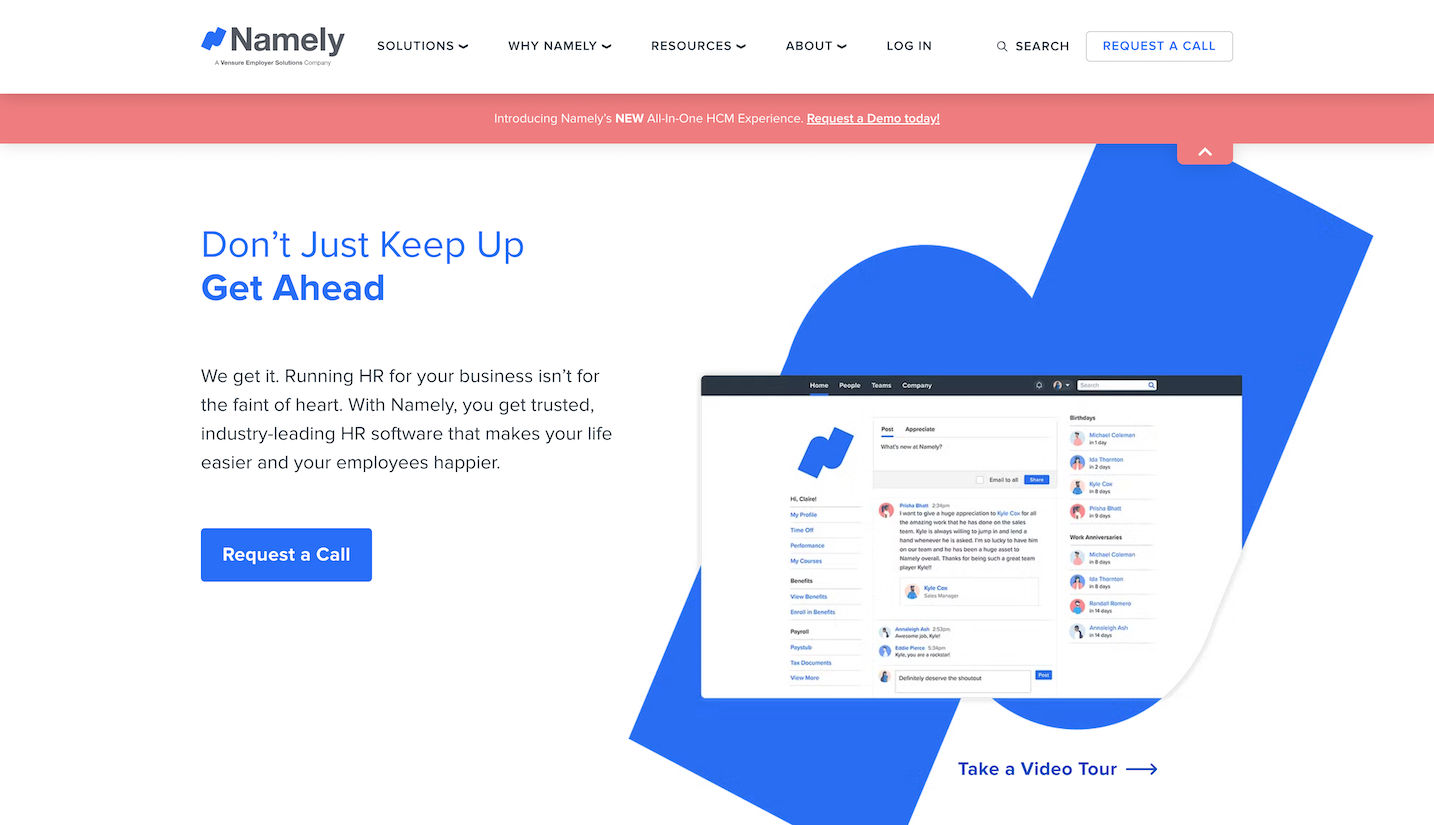
Namely is an HR platform designed for mid-sized companies that value employee engagement and social collaboration. Think of it as the HR system with a social network built in.
Core Functionalities:
- Core HR: Employee database management, organizational charts, and employee self-service portals.
- Benefits Administration: Benefits enrollment, benefits tracking, and compliance management.
- Payroll: Payroll processing, tax filing, and compliance management.
- Time and Attendance: Time tracking, leave management, and attendance reports.
- Talent Management: Performance reviews, goal setting, and succession planning.
- Social Collaboration: Company news feed, employee directory, and group messaging.
What Sets Namely Apart:
Namely distinguishes itself with its social collaboration features, which enable employees to connect, communicate, and collaborate with each other. The platform also offers a robust benefits administration system and a user-friendly interface.
The Narrative:
“Innovate Marketing,” a fast-growing marketing agency, wanted to create a more connected and collaborative work environment. They were impressed by Namely’s social collaboration features.
“Innovate Marketing” chose Namely. The platform’s company news feed allowed employees to stay informed about company events and announcements, while the employee directory made it easy for them to find colleagues with specific skills and expertise. The group messaging feature enabled employees to collaborate on projects more effectively.
Pricing:
Namely’s pricing is typically on a per-employee per-month basis, with costs depending on the features selected. The cost is on the higher side.
Pros:
- Social collaboration features
- Robust benefits administration
- User-friendly interface
- Scalable to handle growing businesses
Cons:
- Higher cost compared to some other platforms
- Limited customization options
- May be overkill for small businesses with simple HR needs
Verdict:
Namely is a great option for mid-sized companies that value employee engagement and social collaboration. The platform’s social collaboration features can help create a more connected and collaborative work environment.
9. ADP Workforce Now: The Scalable Solution with Extensive Expertise
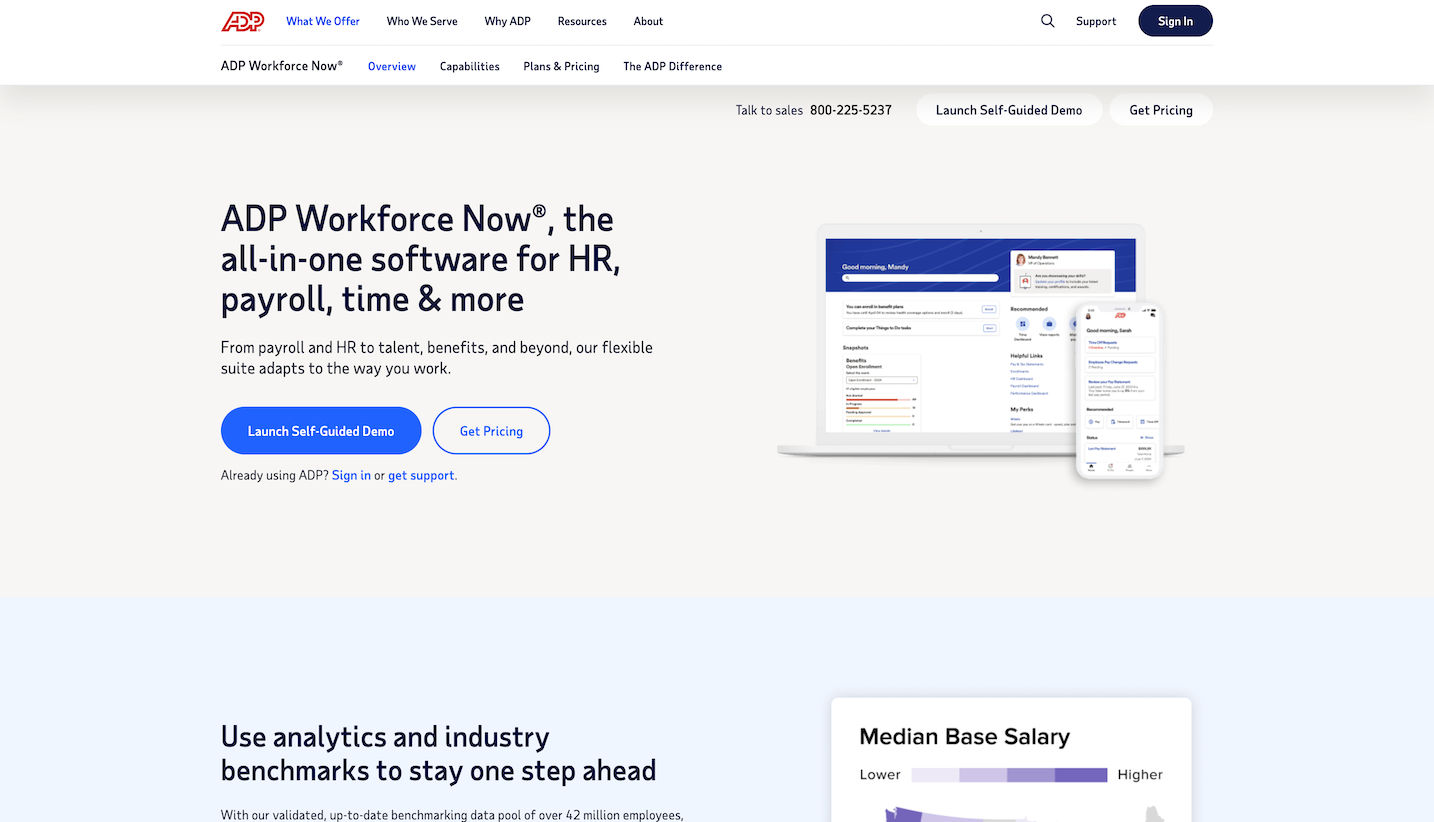
ADP Workforce Now is a comprehensive HR and payroll platform designed for businesses of all sizes, from small businesses to large enterprises. Think of it as the experienced consultant who can guide you through any HR challenge.
Core Functionalities:
- Core HR: Employee database management, organizational charts, and employee self-service portals.
- Payroll: Payroll processing, tax filing, and compliance management.
- Benefits Administration: Benefits enrollment, benefits tracking, and compliance management.
- Time and Attendance: Time tracking, leave management, and attendance reports.
- Talent Management: Performance reviews, goal setting, and succession planning.
- Recruitment: Job postings, applicant tracking, and onboarding processes.
- Learning Management: Training modules, course management, and employee development resources.
- Analytics: Workforce analytics, dashboards, and custom reporting.
What Sets ADP Workforce Now Apart:
ADP Workforce Now distinguishes itself with its scalability, its extensive expertise in HR and payroll compliance, and its comprehensive suite of services. The platform can be tailored to the specific needs of your business, and ADP’s team of experts can provide guidance and support on any HR issue.
The Narrative:
“Global Retail,” a rapidly expanding retail chain, needed a robust and scalable HR platform that could support its growing workforce and complex HR needs. They chose ADP Workforce Now.
ADP Workforce Now provided Global Retail with a comprehensive suite of services, including payroll processing, benefits administration, and time and attendance tracking. The platform was able to scale to meet the company’s growing needs, and ADP’s team of experts provided guidance and support on HR compliance issues.
Pricing:
ADP Workforce Now’s pricing is typically on a per-employee per-month basis, with costs depending on the features selected. The cost is on the higher side.
Pros:
- Scalable to handle businesses of all sizes
- Extensive expertise in HR and payroll compliance
- Comprehensive suite of services
Cons:
- Higher cost compared to some other platforms
- Can be complex to implement and use
- Customer service can be inconsistent
Verdict:
ADP Workforce Now is a great option for businesses of all sizes that need a robust and scalable HR and payroll platform. The platform’s comprehensive suite of services and ADP’s team of experts can provide the support and guidance you need to manage your workforce effectively.
10. Sage HR: The Cloud-Based Solution for Streamlined HR Management
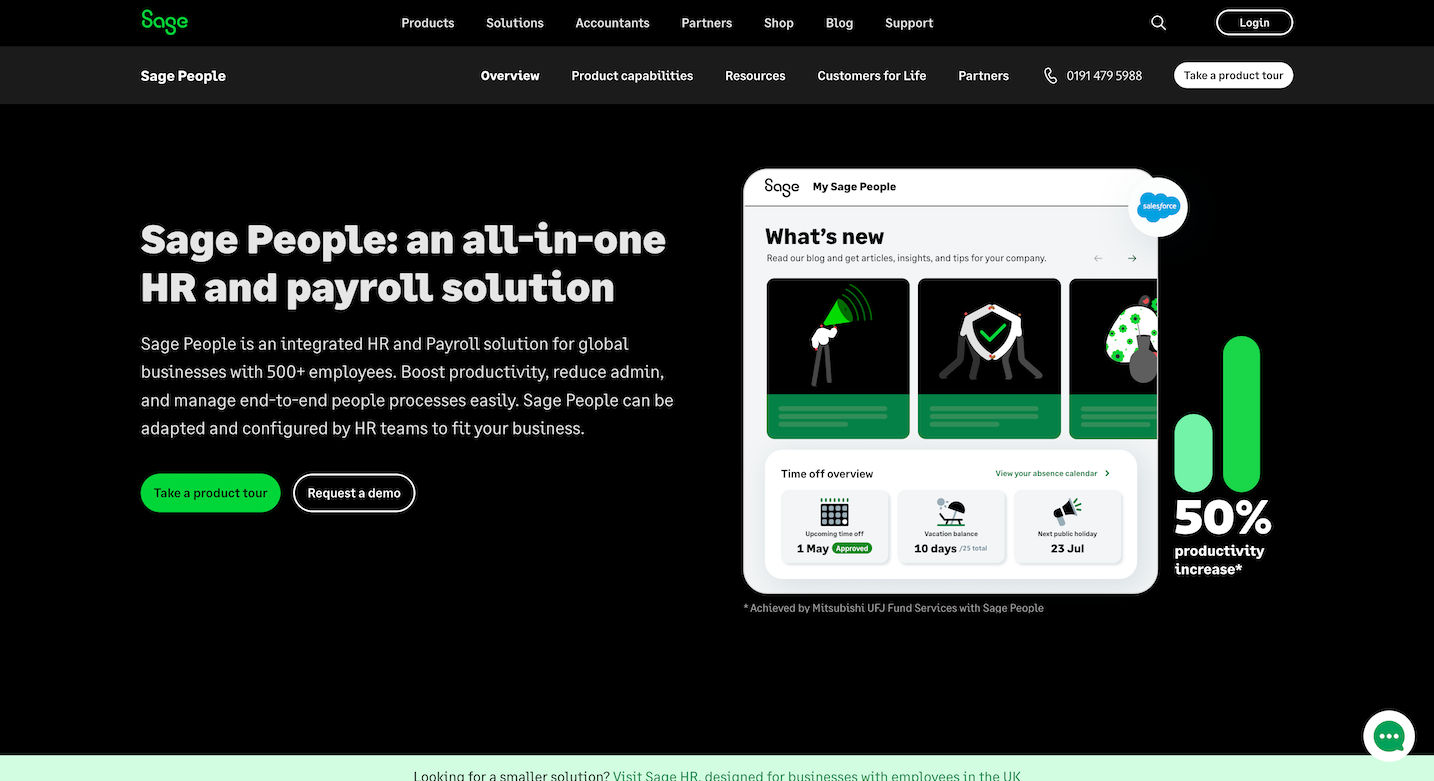
Sage HR (formerly Fairsail) is a cloud-based HR management system designed to help small and medium-sized businesses streamline their HR processes. Think of it as the efficient assistant that takes care of routine HR tasks.
Core Functionalities:
- Core HR: Employee database management, organizational charts, and employee self-service portals.
- Leave Management: Automated leave request and approval workflows.
- Performance Management: Performance reviews, goal setting, and feedback mechanisms.
- Time Tracking: Time tracking and attendance reports.
- Recruitment: Job postings, applicant tracking, and onboarding processes (often through integrations).
- Reporting & Analytics: Customizable reports and dashboards to track HR metrics.
What Sets Sage HR Apart:
Sage HR distinguishes itself with its user-friendly interface and its focus on core HR functionalities. It’s designed to be easy to use and implement, even for businesses with limited HR expertise. It integrates well with other Sage products, making it a good choice for businesses that already use Sage accounting or ERP software.
The Narrative:
“Sustainable Goods,” a growing e-commerce company, needed a simple and easy-to-use HR system to manage its workforce. They chose Sage HR.
Sage HR provided Sustainable Goods with a centralized platform for managing employee data, tracking leave, and conducting performance reviews. The platform’s user-friendly interface made it easy for employees to access their information and complete HR tasks.
Pricing:
Sage HR offers various pricing plans based on the features you need. The pricing is on the competitive side, making it a good option for small businesses.
Pros:
- User-friendly interface
- Focus on core HR functionalities
- Integration with other Sage products
- Competitive pricing
Cons:
- Limited customization options
- May lack advanced features found in more expensive platforms
- Recruitment features are often through integrations
Verdict:
Sage HR is a good option for small and medium-sized businesses looking for a simple and easy-to-use HR system to streamline their HR processes. It’s particularly well-suited for businesses that already use other Sage products.
Conclusion: Choosing the Right HR System for Your Small Business
Selecting the right HR system is a critical decision for any small business. It’s essential to carefully evaluate your needs, budget, and long-term growth plans before making a choice. Remember to consider factors such as:
- Your Business Size and Complexity: What might be an easy solution for a 5 person business might not be suitable for a 50 employee business.
- Your HR Needs: Do you need a comprehensive solution that covers all aspects of HR, or are you primarily looking for a system to manage payroll and benefits?
- Your Budget: HR systems can range in price from a few dollars per employee per month to several hundred dollars per employee per month.
- Your Technical Expertise: How comfortable are you with technology? Some HR systems are easier to use than others.
- Your Integration Needs: Do you need the HR system to integrate with other systems, such as accounting software or CRM?
By carefully considering these factors, you can choose an HR system that will help you streamline your HR processes, improve employee engagement, and drive business success.
